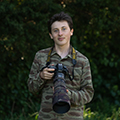Visit the exhibition
Discover the incredible stories of life on our planet through powerful photography and expert insight.
Tickets on sale now.

D’Artagnan Sprengel (New Zealand) shows the starfish nestled on the shore, the evening light emphasising its rich colour.
D’Artagnan had set his heart on photographing the hand-sized reef starfish. ‘It was visible for about 10 minutes, only when the tide was at its lowest,’ he explains. ‘Even then, I had to run back and forth every 30 seconds between waves.’
His sprints and rapid camera work, with a low, wide angle, paid off, capturing this starfish among the mussel shells, its rich hues picked out by the soft twilight.
Reef starfish play a vital role in controlling populations of New Zealand green-lipped mussels by feeding on them. Without the reef starfish, the mussels could outcompete other species on the shoreline.
Positioning itself over a mussel, the starfish either locates a small hole at the base of the mussel’s shell or forces the shell open using rows of suckers on its underside. It then turns its stomach inside out through its mouth and inserts it into the opening in the shell. Using digestive juices to break down the mussel’s tissues, it then sucks up the resulting soup.
Discover the incredible stories of life on our planet through powerful photography and expert insight.
Tickets on sale now.

New Zealand
D'Artagnan has been taking photos since he was 10 years old. On his eleventh birthday he got his first DSLR camera and from there photography become his love, joy and passion. He now spends almost every minute of his spare time taking images and editing them. He mainly focuses on bird and macro photography, as there are few land mammals in New Zealand, but he also enjoys astro and landscape photography as well.
Help us harness the power of photography to advance scientific knowledge, spread awareness of important issues and nurture a global love for nature.